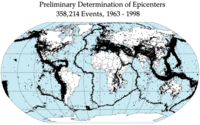
Photo from wikipedia
We present a high‐resolution 2‐D P‐wave velocity model from a 225‐km‐long active seismic profile, collected over ~60–75 Ma central Atlantic crust. The profile crosses five ridge segments separated by a… Click to show full abstract
We present a high‐resolution 2‐D P‐wave velocity model from a 225‐km‐long active seismic profile, collected over ~60–75 Ma central Atlantic crust. The profile crosses five ridge segments separated by a transform and three nontransform offsets. All ridge discontinuities share similar primary characteristics, independent of the offset. We identify two types of crustal segment. The first displays a classic two‐layer velocity structure with a high gradient Layer 2 (~0.9 s−1) above a lower gradient Layer 3 (0.2 s−1). Here, PmP coincides with the 7.5 km s−1 contour, and velocity increases to >7.8 km s−1 within 1 km below. We interpret these segments as magmatically robust, with PmP representing a petrological boundary between crust and mantle. The second has a reduced contrast in velocity gradient between the upper and lower crust and PmP shallower than the 7.5 km s−1 contour. We interpret these segments as tectonically dominated, with PmP representing a serpentinized (alteration) front. While velocity‐depth profiles fit within previous envelopes for slow‐spreading crust, our results suggest that such generalizations give a misleading impression of uniformity. We estimate that the two crustal styles are present in equal proportions on the floor of the Atlantic. Within two tectonically dominated segments, we make the first wide‐angle seismic identifications of buried oceanic core complexes in mature (>20 Ma) Atlantic Ocean crust. They have a ~20‐km‐wide “domal” morphology with shallow basement and increased upper crustal velocities. We interpret their midcrustal seismic velocity inversions as alteration and rock‐type assemblage contrasts across crustal‐scale detachment faults.
Journal Title: Journal of Geophysical Research
Year Published: 2020
Link to full text (if available)
Share on Social Media: Sign Up to like & get
recommendations!